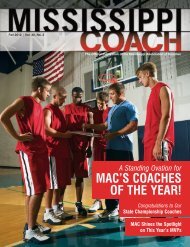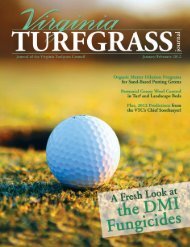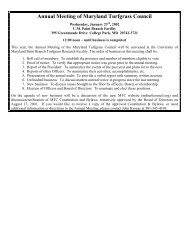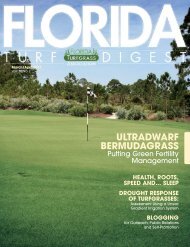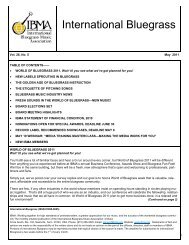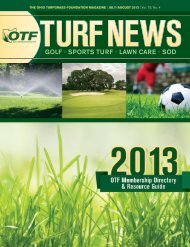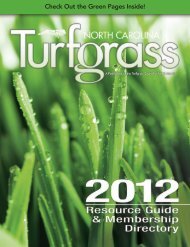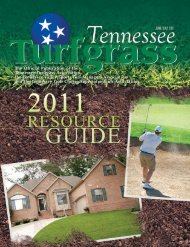the Fate of Field Paspalum Control - The Paginator
the Fate of Field Paspalum Control - The Paginator
the Fate of Field Paspalum Control - The Paginator
You also want an ePaper? Increase the reach of your titles
YUMPU automatically turns print PDFs into web optimized ePapers that Google loves.
APPLIED RESEARCH • continued<br />
controlled-release N sources. Using<br />
slow-release sources, including organics,<br />
also reduces surge growth, reducing<br />
mowing requirements relative to<br />
using quick-release N sources.<br />
BMP#6: Do not apply fertilizers to<br />
frozen soils.<br />
Several studies have noted that 60% to<br />
90% <strong>of</strong> P-run<strong>of</strong>f occurs during winter<br />
thawing periods when <strong>the</strong> surface soil<br />
is still frozen. Such large run<strong>of</strong>f events<br />
occur because <strong>the</strong> soils are ei<strong>the</strong>r frozen<br />
or saturated, prohibiting water<br />
infiltration and allowing soil- or leaflitter-bound<br />
P present in open soil<br />
areas to be quickly lost. Applying P-<br />
containing fertilizers too late (November<br />
or December) or too early (February<br />
or March) greatly increases <strong>the</strong><br />
potential <strong>of</strong> P loading into Bay waters.<br />
BMP#7: Do not apply fertilizer to<br />
impervious surfaces; immediately<br />
sweep or blow any granules back<br />
onto <strong>the</strong> lawn.<br />
Fertilizer, compost, grass clippings and<br />
tree leaves all contain nutrients. As<br />
such, it is irresponsible to leave any<br />
<strong>of</strong> <strong>the</strong>m on impervious surfaces<br />
where <strong>the</strong>y can move unimpeded<br />
into storm drains.<br />
BMP#8: Mow high, and follow <strong>the</strong><br />
1/3 rule.<br />
This BMP is all about maintaining<br />
density and high biomass on your<br />
lawn: both factors increase water-flow<br />
resistance, slowing run<strong>of</strong>f and increasing<br />
infiltration. Mowing turf at <strong>the</strong><br />
higher end <strong>of</strong> recommended ranges<br />
(3" – 4" for bluegrass and fescue; 1.5"<br />
– 2.5" for bermudagrass and zoysiagrass)<br />
will accomplish this, while also<br />
providing a deeper-rooted, more stresstolerant<br />
lawn.<br />
Mowing high also means you can<br />
mow less frequently without breaking<br />
<strong>the</strong> 1/3 rule. <strong>The</strong> 1/3 rule is to never<br />
remove more than 33% (1/3) <strong>of</strong> <strong>the</strong><br />
grass height at one mowing. Repeatedly<br />
removing too much at each mowing<br />
(e.g., mowing a 5" lawn down to<br />
2" = 60% removal) results in a shallow<br />
root system that produces turf<br />
thinning and weed invasion. For fescue<br />
lawns, not breaking <strong>the</strong> 1/3 rule means<br />
mowing back to a 3" height each<br />
time <strong>the</strong> lawn reaches 4.5".<br />
BMP#9: Leave clippings on <strong>the</strong><br />
lawn, removing any that reach<br />
impervious surfaces.<br />
Grass clippings contain 2% to 5% N<br />
and about 0.5% P, and <strong>the</strong>y break<br />
down quickly, re-releasing <strong>the</strong>se nutrients<br />
for root uptake. Clipping return<br />
can serve as an organic fertilizer, providing<br />
more than 1 lb. N/1,000 ft 2 /yr.<br />
Left on <strong>the</strong> street, however, <strong>the</strong>se<br />
nutrients can quickly move into storm<br />
drains to pollute <strong>the</strong> Bay. If large clipping<br />
clumps accumulate, ei<strong>the</strong>r rake<br />
<strong>the</strong>m up and compost <strong>the</strong>m on-site,<br />
or mow <strong>the</strong> lawn in 2-3 directions to<br />
disperse <strong>the</strong>m.<br />
BMP#10: Mulch tree leaves into<br />
<strong>the</strong> lawn and clean up any that<br />
accumulate on impervious surfaces.<br />
Studies at Michigan State, Purdue and<br />
Cornell have documented that mulching<br />
a 2" to 5" layer <strong>of</strong> deciduous tree<br />
leaves onto cool-season lawns for three<br />
to five consecutive autumns had no<br />
significant effects on lawn health or<br />
vigor. <strong>The</strong>se studies also reported no<br />
increases in thatch or undue reduction<br />
in soil pH due to this practice.<br />
Recycling tree leaves back into your<br />
lawn is safer for <strong>the</strong> environment than<br />
piling <strong>the</strong>m on <strong>the</strong> street and risking<br />
<strong>the</strong> loss <strong>of</strong> N and P to stormwater run<strong>of</strong>f.<br />
Mowing when <strong>the</strong> leaves are dry<br />
mulches <strong>the</strong>m much more effectively.<br />
BMP#11: Irrigate only if severe<br />
drought persists and threatens to<br />
significantly reduce turf cover.<br />
Adherence to <strong>the</strong> first 10 BMPs should<br />
result in a fairly deep-rooted lawn that<br />
should recover from summer droughts<br />
<strong>of</strong> two to three weeks. Droughts <strong>of</strong><br />
more than four weeks could result in<br />
<strong>the</strong> loss <strong>of</strong> some turf cover, especially<br />
if <strong>the</strong>re is any traffic on <strong>the</strong> lawn during<br />
drought-dormancy. In this case,<br />
lawn cover should be preserved by<br />
applying 0.75" to 1" <strong>of</strong> water per<br />
week until rainfall returns.<br />
BMP#12: Use pesticides only<br />
when weed, insect or disease levels<br />
threaten to significantly thin <strong>the</strong> lawn;<br />
strictly follow label directions.<br />
Careful application <strong>of</strong> <strong>the</strong> preceding<br />
BMPs to ensure a dense, healthy lawn<br />
should greatly minimize <strong>the</strong> need<br />
for pesticides.<br />
For homeowners who wish to have<br />
lawns that are environmentally friendly<br />
or more sustainable than what current<br />
suburban development gives <strong>the</strong>m,<br />
<strong>the</strong>re are two primary choices: take<br />
what you are given and improve it<br />
by following <strong>the</strong>se 12 BMPs, or start<br />
over by improving <strong>the</strong> soil and establishing<br />
a no-mow prairie and herbaceous/woody<br />
perennial landscape.<br />
Simply stopping all management<br />
inputs and calling it a “Freedom<br />
Lawn” is easy and cheap, but it may<br />
ultimately be irresponsible. •<br />
20 MTC TURF NEWS




